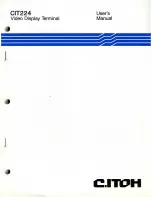
Read multiple holding registers (function code 3)
Write single holding register (function code 6)
Write multiple holding registers (function code 16)
Read/Write multiple registers (function code 23)
The following data can be accessed using both Modbus/TCP and Modbus/RTU:
Device measurements
Device I/O
Commands
Events
Time
Once the con guration le has been loaded, the user can access the Modbus map of the relay via the
AQtivate software (
Tools
→
Communication
→
Modbusmap
). Please note that holding registers start
from 1. Some masters might begin numbering holding register from 0 instead of 1; this will cause an
offset of 1 between the relay and the master.
Table. 6.1.2. - 119. Modbus/TCP settings.
Parameter
Range
Description
Modbus/TCP
Enable
0:
Disabled
1: Enabled
Enables and disables the Modbus/TCP on the Ethernet port.
IP port
0…65 535 De nes the IP port used by Modbus/TCP. The standard port (and the default setting) is
502.
Table. 6.1.2. - 120. Modbus/RTU settings.
Parameter
Range
Description
Slave address
1…247
De nes the Modbus/RTU slave address for the unit.
Additionally, the user can adjust the measurement update interval with the following parameters (found
at
Measurement
→
Measurement update
). These parameters do not affect the operating times of
protection functions, only the frequency of measurement reporting to Modbus.
Table. 6.1.2. - 121. Settings for measurement update interval.
Name
Range
Step Default
Description
Current measurement update
interval
500…10
000 ms
5 ms
2 000
ms
De nes the measurement update interval of all current-
related measurements.
Voltage measurement update
interval
500…10
000 ms
5 ms
2 000
ms
De nes the measurement update interval of all voltage-
related measurements.
Power measurement update
interval
500…10
000 ms
5 ms
2 000
ms
De nes the measurement update interval of all power-
related measurements.
Impedance
measurement update interval
500…10
000 ms
5 ms
2 000
ms
De nes the measurement update interval of all impedance-
related measurements.
6.1.3. Modbus I/O
The Modbus I/O protocol can be selected to communicate on the available serial ports. The Modbus
I/O is actually a Modbus/RTU master implementation that is dedicated to communicating with serial
Modbus/RTU slaves such as RTD input modules. Up to three (3) Modbus/RTU slaves can be
connected to the same bus polled by the Modbus I/O implementation. These are named I/O Module A,
I/O Module B and I/O Module C. Each of the modules can be con gured using parameters in the
following two tables.
AQ-E215
Instruction manual
Version: 2.01
143
© Arcteq Relays Ltd
















































